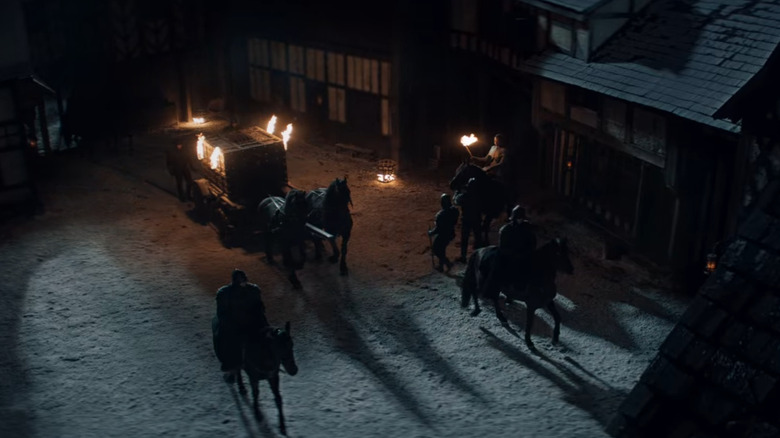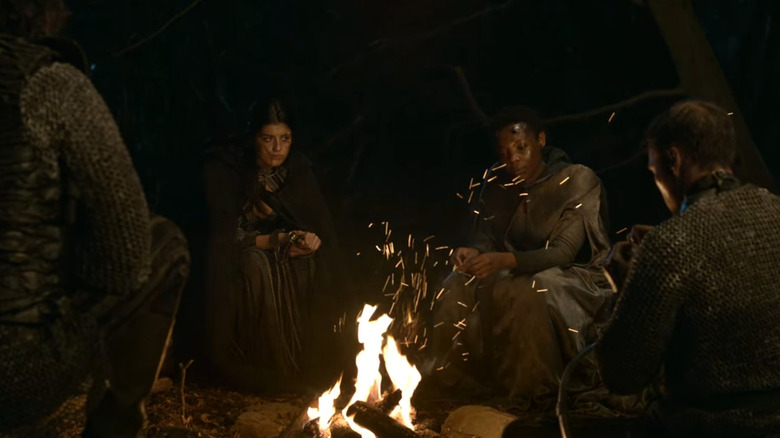Dimeritium In The Witcher Explained
Magic is a powerful tool in the world of Netflix's hit series "The Witcher," based on the novels by Andrzej Sapkowski. In order to control powerful mages and keep their best weapon out of their hands (their magic), folks have learned how to harness a metallic substance called dimeritium that suppresses magical power. Dimeritium is used in season 1 to keep the powerful mage Mousesack contained and quiet, and we see it used on Yennefer early in season 2, but how dimeritium works and is used aren't explained all that well in the Netflix series. So let's take a deeper look at this magic-dampening material in the source novels, the series, and the video game series by CD Projekt RED.
Warning: Minor spoilers for "The Witcher" season 2 follow.
A Dimeritium Cage for Mousesack
In the fifth episode of the first season of "The Witcher," "Bottled Appetites," we see Mousesack (Adam Levy) kept in a metal cage-type carriage. When he's released before his captor, the Nilfgaardian mage Fringilla (Mimi Ndiweni), he vomits white bile and seems horribly weakened. The cage likely has dimeritium in its bars, causing him to be cut off from his Chaos (or magic), which can cause severe discomfort. He is also kept in dimeritium handcuffs, preventing him from using any sigils or teleportation magic. Fringilla isn't afraid to use forbidden magic, despite the fact that she was raised in the same system as Yennefer (Anya Chalotra) and Mousesack, and it appears that she's not afraid to use dimeritium against her fellow mages, either. In season 2, we see Yennefer, her former schoolmate, shackled with dimeritium when she's held captive by Fringilla. She even throws dimeritium powder in Tissaia's (MyAnna Buring) face, weakening the powerful mage for some time.
So how does Fringilla use the dimeritium on her opponents without having her own powers dampened? In the case of the powder, she likely has some kind of protective element in her gloves. And for the cage/restraints? The most popular fan theory is that in order to suppress magic completely, it must "contain" the magic. That's why the person in cuffs or in the cage is affected, while someone standing beside them is not. When all else fails, just remember — it's magic!
Dimeritium in the Witcher Games
While "The Witcher" series on Netflix is based directly on the book series and not the popular video game adaptations, there are bits of lore in the games that are expansions on the book's canon and have found their way into the TV series. In the first game, players can find a quest item called the Tower Mage's Book. Contained within are two bits of lore, and one of those is a full description of dimeritium. It reads:
"Dimeritium is a rare and precious metal with an interesting feature — it represses the transfer of magical energy. A bluish alloy of iron and dimeritium is used to produce handcuffs and necklaces. Those who wear them cannot cast spells or use magic in any way. There are known cases, however, of extraordinarily powerful sorcerers managing to overcome the shield generated by dimeritium."
In the video games, Geralt can use dimeritium to make bombs and powerful weapons. It will be interesting to see how they continue to weave the complex world of the "Witcher" novels into the Netflix series, and if dimeritium will continue to hamper even the feistiest of mages.
Season 2 of "The Witcher" is now streaming on Netflix.


